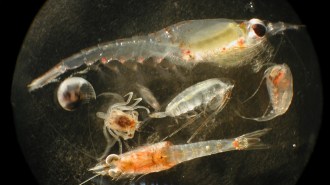Fire Retardant Catfish?
It may sound like a barbecue chefs dream: fish that wont catch fire and char when their fat spatters onto overly hot charcoal. But the facts are less appealing. Although many U.S. fish contain fire retardants, they wont protect your grilled fare from burning. In fact, these compounds, which go by the name of polybrominated diphenyl ethers, or PBDEs, are industrial pollutants. Emerging data suggest that PBDEs are probably hormone-mimicking poisons–a nutritional nightmare instead of a culinary dream.

To many environmental scientists, PBDEs represent just the latest addition to a growing alphabet soup of toxic agents tainting our food supply. Like DDT, PCBs, PBBs, and HCH, these organic chemicals are soluble in lipids. Once they enter the environment, they often accumulate in insulating fat of animals–fish, birds, even polar bears.
Consumption of tainted fish may bring their accumulated stores of PBDEs to the dinner table. At least, thats one concern raised by Robert C. Hale and his colleagues at the Virginia Institute of Marine Science (VIMS) in Gloucester Point in the Dec. 1 Environmental Science & Technology.
Hale and his colleagues happened upon the pollutant in Virginia rivers after they were asked to analyze fish from those waters for PCBs (polychlorinated biphenyls). Their assays also turned up PBDEs at concentrations that went through the roof, Hale recalls.
The predominant type detected was penta-PBDE, molecules containing four to six bromine atoms. Because U.S. manufacturers rely on these pentas in the production of polyurethane foam, Hale drove out to the river-sampling sites fully expecting to see a major foam-production plant. But we were baffled, he told Science News Online, because all we found were a boat landing, trees, and some farms.
Indeed, Hale says that you would never guess, looking at the areas where we have seen fish with the highest [PBDE] concentrations, that there would be any pollution problem there.
In all, the VIMS team collected 332 fish, sampled from 133 sites within the Roanoke and Dan River watersheds. These fish included 33 different freshwater species, such as sunfish, white bass, carp, and channel catfish.
Fully 89 percent of the fish contained detectable concentrations of BDE-47, a component of penta formulations. Concentrations of it exceeded 100 micrograms per kilogram (mg/kg) of tissue in more than half of the sampled fish, and some of those collected from 16 separate sites had residue levels at least 10 times that high.
As is commonly seen with other fat-soluble pollutants, the heaviest accumulations of this PBDE showed up in the largest and oldest animals. Hale says this presumably reflects the animals gradual accumulation of the flame retardants through consumption of moderately tainted prey.
Rivals PCB and DDT tainting
One or more types of PCB have typically shown up in some 97 percent of U.S. fish. DDE, a hormone-mimicking breakdown product of DDT, taints almost as many.
However, in more than half of the fish that the VIMS scientists tested, concentrations of the PBDE called BDE-47 surpassed those of PCB-153–the most prevalent PCB in area waters. Detectable BDE-47 concentrations also exceeded those of DDE in 29 percent of the fish sampled.
Indeed, one carp (Cyprinus carpio) that the scientists assayed establishes a new world record for PBDE contamination–47,900 mg/kg of tissue. The decades-old fish had been residing in rural Virginias small Hyco River.
Until this new finding, a Swedish perch had held the dubious title of most PBDE-tainted at 36,900 mg/kg.
However, Hale observes, the really troubling part of such comparisons is that whereas use of PBDEs in Europe–and their concentrations in the environment–tend to be falling, production and contamination in this country continue to climb steadily. The European Union is considering a ban on almost all PBDEs (SN: 9/29/01, p. 207: EU moves against flame retardants).
PBDEs moving up the food chain
The new VIMS study is far from the first to show that PBDEs can taint fish. Earlier this year, another study in Environmental Science & Technology reported that Lake Michigan salmon averaged about 2,440 mg/kg of the flame retardants–with BDE-47s share typically accounting for about 65 percent.
Again, concentrations tended to rise with the size and age of the fish. It would appear that in this huge lake, PBDEs are as prevalent as PCBs, noted Jon B. Manchester-Neesvig of the University of Wisconsin and his colleagues.
The flame retardants are even turning up in breast milk and the fat of people–both in North America and Europe. Not surprisingly, concentrations in people tend to correlate with their consumption of fish, according to a study reported last year by Andreas Sjödin of Stockholm University in Sweden and his colleagues.
So, is it important that traces of PBDEs are accumulating inside us?
Unfortunately, the toxicology of these compounds has not kept pace with assays defining its ubiquity in the environment. The few preliminary investigations of toxicity that do exist suggest that these pollutants not only mimic estrogen but also alter body concentrations of thyroid hormones. Both reproductive and thyroid hormones play major roles choreographing human development and brain function.
As with PCBs, PBDEs appear capable–at least in laboratory animals–of impairing learning and memory, note Per Eriksson of Uppsala University in Sweden and his colleagues. His teams experiments, reported a few months ago, also identified permanent aberrations in the behavior of animals exposed to BDE-47 and another PBDE shortly after birth.
The good news, notes Per Ola Darnerud of the National Food Administration in Uppsala, Sweden, and his colleagues, is that concentrations of the flame retardants that are typically found in people today fall well below those producing harm in animals. Still, the rapid rise in breast-milk concentrations since the 1970s is alarming, his team reported in March 2001.
To minimize exposures. . .
The new studies offer a few clues for minimizing exposures. Because fish tend to be a major source of these pollutants in the human diet, diners might want to avoid big fish from freshwater lakes and streams. Worried anglers also might want to shift their consumption patterns from predators–such as trout, salmon, and carp–to their smaller prey, such as sunfish.
Finally, because PBDEs tend to accumulate in fat, cooks should consider broiling fish in such a way that excess fat can drip off.







